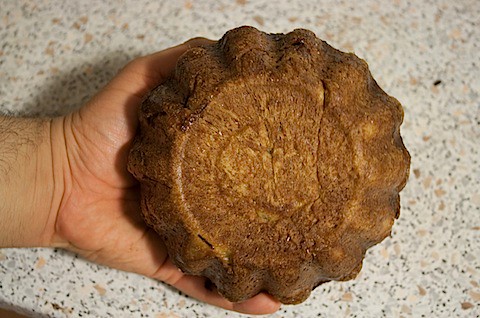The bakery in my street has pretty amazing bread, but their brioche is, well, not-so-amazing. It's made in muffin tins and, even though it has the tête, it's just not what I wanted. I wanted something specific, something just like- no- exactly like the buttery richness of the brioche from the beginning of the Bread Baker's Apprentice Challenge.
I wanted that brioche.

But I didn't make it. I spent about another week trying to find some- which is near impossible here in Berlin- before I remembered that Peter Reinhart's Whole Grain Breads has a recipe for Whole Wheat Brioche.
The recipe follows Reinhart's Epoxy Method, where two unlike doughs meet to create a stronger better dough. The soaker is essentially the water and salt, and probably serves as an extended autolyse of the flour, as well as to develop flavor. The starter or biga has a minimal amount of yeast, and also develops flavor, but also allows the yeast to multiply so that less yeast is needed overall. In this case, the soaker consisted of scalded milk, butter, flour and salt. The starter had the eggs, along with flour and yeast.
Both mixtures were difficult to work with because they were so thick. I wanted more liquid in the mixtures to make them easier to work with, but that didn't happen. I just mixed as well as I could and stuck the two mixtures in the fridge.
After a night and day of refrigeration, I took them out and mixed them together. Because they were so cold, they refused to mix, and I had to allow them to come to room temperature before they would even merge.

I sort of messed up in this part. After the mixing, the dough is supposed to go directly into the molds. I let it rise in a bowl before checking on the time in the book. I molded them about two hours into the first and only rise.

So, because this is supposed to be My Bread Year, overbrowned warts and all, I am presenting all breads as they came out. You may remember my Stollen disaster. No? Oh, maybe that's because I'm getting ahead of myself.
The electric oven I work with has an exposed element at the top, so breads usually come out browner than I usually want. Somehow, I seem to never learn my lesson, and usually let things become darker than usual. Though the dark bits were still delicious, the brioche would have looked even better if it hadn't been so dark.

But the bottom came out great!
As for the taste? Heavenly.
Well, at least when the bread was warm. It tasted completely like pancakes. The whole grain was sweet and nutty and the butter was just enough to make the crumb so tender. It was amazing.
The bad part? Well, when cool, the bread was dry and tasted a bit bland. I'm not sure why. Perhaps because the recipe has very little sugar, or because there wasn't enough butter.
Or, if I may completely take a wild guess. When warm, the bread was probably releasing more aromas, which helped make it taste better.
I'm still craving brioche, but not as much. I even paid a visit to Galeries Lafayette, thinking that if I couldn't find brioche there, I would give up. I found some, and it was good, but it wasn't the exact brioche I wanted. Again, not enough butter.

